|
|
|
Sort Order |
|
|
|
Items / Page
|
|
|
|
|
|
|
| Srl | Item |
| 1 |
ID:
121377


|
|
|
|
|
| Publication |
2013.
|
| Summary/Abstract |
Interest in the role embodied energy plays in international trade and its subsequent impact on energy security has grown. As a developed nation, the UK's economic structure has changed from that of a primary producer to that of a primary consumer. Although the UK's energy consumption appears to have peaked, it imports a lot of energy embodied in international trade alongside the more obvious direct energy imports. The UK has seen increasing dependency on imported fossil energy since the UK became a net energy importer in 2005. In this paper an energy input-output model is established to calculate not only the amount of fossil energy embodied in UK's imports and exports, but also the sector and country distributions of those embodied fossil energy. The research results suggest the following: UK's embodied fossil energy imports have exceeded embodied fossil energy exports every year since 1997, UK embodied energy imports through the so-called 'Made in China' phenomena are the largest accounting for 43% of total net fossil energy imports. If net embodied fossil energy imports are considered, the gap between energy consumption and production in UK is much larger than commonly perceived, with subsequent implications to the UK's energy security.
|
|
|
|
|
|
|
|
|
|
|
|
|
|
|
|
| 2 |
ID:
132602
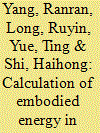

|
|
|
|
|
| Publication |
2014.
|
| Summary/Abstract |
In order to find efficient trade measures to reduce China×s energy consumption and to provide theoretical support for the climate talks between China and America, we investigate the impact of Sino-USA trade on energy consumption from the perspective of embodied energy. An Environmental Input-Output Life Cycle Assessment (EIO-LCA) model was established to calculate the total energy consumption coefficient, the direct consumption coefficient and the complete consumption coefficient of the sectors of the national economies of China and America. After taking into consideration the data of every sector of the national economy in Sino-USA trade, energy embodied in the import and export trade between China and America was calculated to verify the real energy flows in Sino-USA trade. The research results suggest the following: China is the net exporter of embodied energy in Sino-USA trade, and coal, crude oil and natural gas are the major components. In 1997-2011, the net exports of China×s embodied energy totaled 1523,082,200 t of standard coal, the amount of China×s energy consumption increased by 895,527,900 t of standard coal, and America×s energy consumption decreased by 11,871,200 t of standard coal as a result of Sino-USA trade. On this basis, corresponding policies and recommendations are proposed.
|
|
|
|
|
|
|
|
|
|
|
|
|
|
|
|
| 3 |
ID:
105797


|
|
|
|
|
| Publication |
2011.
|
| Summary/Abstract |
Traditionally the majority of building energy use has been linked to its operation (heating, cooling, lighting, etc.), and much attention has been directed to reduce this energy use through technical innovation, regulatory control and assessed through a wide range of rating methods. However buildings generally employ an increasing amount of materials and systems to reduce the energy use in operation, and energy embodied in these can constitute an important part of the building's life cycle energy use. For buildings with 'zero-energy' use in operation the embodied energy is indeed the only life cycle energy use. This is not addressed by current building energy assessment and rating methods.
This paper proposes a methodology to extend building energy assessment and rating methods accounting for embodied energy of building components and systems. The methodology is applied to the EU Building Energy Rating method and, as an illustration, as implemented in Irish domestic buildings. A case study dwelling is used to illustrate the importance of embodied energy on life cycle energy performance, particularly relevant when energy use in operation tends to zero. The use of the Net Energy Ratio as an indicator to select appropriate building improvement measures is also presented and discussed.
|
|
|
|
|
|
|
|
|
|
|
|
|
|
|
|
| 4 |
ID:
097204
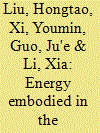

|
|
|
|
|
| Publication |
2010.
|
| Summary/Abstract |
Growing international trade has not only positively affected the People's Republic of China's (China's) economic development, but also expanded the exportation of energy embodied in goods during their production. This energy flow out will pose risks to China's rational utilization of natural resources as well as environmental protection. In this paper, we evaluate the energy embodied in goods produced in China during 1992-2005 and use input-output structural decomposition analysis to identify five key factors causing the changes of energy embodied in exports. (Direct primary energy efficiency, primary energy consumption structure, structure of intermediate inputs, structure of exports, and scale of exports.) For the three sub-periods of 1992-1997, 1997-2002, and 2002-2005, results show that China is a net exporter of energy, and the energy embodied in exports tends to increase over time. The expanding total volume of exports and increasing exports of energy-intensive goods tend to enlarge the energy embodied in exports within all three sub-periods, but these driving forces were offset by a considerable improvement of energy efficiency and changes in primary energy consumption structure from 1992 to 2002 and the effects of structure of intermediate input only in the sub-period from 1992 to 1997. From 2002 to 2005, the sharp augmentation of energy embodied in exports was driven by all the five factors. Our research has practical implications for the Chinese economy. Results of this study suggest that the energy embodied in trade should receive special attentions in energy policies design to limit the energy resource out-flow and pollution generation.
|
|
|
|
|
|
|
|
|
|
|
|
|
|
|
|
| 5 |
ID:
150743
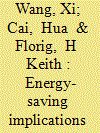

|
|
|
|
|
| Summary/Abstract |
Despite significant public attentions to green supply chain management, few studies have explicitly addressed the energy implications of consumer-goods supply surplus, especially in developing countries like China. This study explored the energy-saving potential from improving supply chain efficiencies and reducing excess inventory in China's retail system from a life-cycle perspective. Through embodied energy analysis, we found that energy invested pre-manufacture contributed 80–95% of the total energy embodied in consumer products. Although embodied energy intensities had declined by 60–90% since the mid-1990s, the lessened marginal improvements implied that "low hanging fruits" have largely been captured, and the search for new opportunities for energy-saving is in demand. Positive correlations between total economic inputs and embodied energy in consumer goods indicated possible synergy effect between cost-reduction and energy-saving in supply system management. And structural path analysis identified sector-specific energy management priorities for each retail-related sector. This study suggested that improving supply chain efficiencies provides a promising supplement to China's current industrial energy-efficient projects which target reducing direct energy use per se as an intra-firm cost-saving measure. From the life-cycle perspective, the definition of "green sector" might have to be reconsidered in China towards a more energy-efficient economy and society.
|
|
|
|
|
|
|
|
|
|
|
|
|
|
|
|
| 6 |
ID:
171357
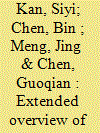

|
|
|
|
|
| Summary/Abstract |
As an extension of our previous study on natural gas use in world economy (Kan et al., Energy Policy 124 (2019) 215–225), this paper explores policy implications based on a time series analysis uncovering the evolution of natural gas use embodied in global supply chains during 2000-2011. Due to increasing gas supply from gas-rich regions to gas-scarce regions and outsourcing of energy-intensive industries, trade imbalance of embodied natural gas is intensifying globally, corresponding to strengthening gas resource relocation and environmental stress shift. Regarding trade patterns, EU and Russia remain the leading (net) importer and exporter of embodied gas, respectively. And global trade relations are diversifying over time, with more suppliers and recipients joining the international trade. Based on the New Policies Scenario provided by IEA, a long term forecast of embodied gas use illustrates need to prepare for a world with changing energy mix, with respect to growing availability of low-cost natural gas and robust demand growth coming from emerging economies, especially China, who is struggling to fight against air pollution through coal-to-gas switch. Potential room to expand natural gas utilization is also targeted, and the expansion requires coordination of all the agents in global supply chains.
|
|
|
|
|
|
|
|
|
|
|
|
|
|
|
|
| 7 |
ID:
166346
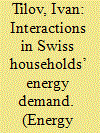

|
|
|
|
|
| Summary/Abstract |
This article analyzes the interactions and possible trade-offs between direct energy consumption and embodied energy requirement of households in Switzerland in order to assess the net impacts of standard energy policies focusing exclusively on direct energy use. Direct and embodied energy demand of Swiss households are estimated by combining consumption data of a national expenditure survey with data on energy intensity from life-cycle analysis. Using a system of equations and an instrumental variable approach, we find that both domains are driven by same determinants, but that there is no evidence for significant substitution between them. We also find an increasing effect of income on both domains, with particularly important effects on embodied energy. From a policy perspective, our findings highlight a concern that economic growth could bring about an increasing global energy demand through energy requirement for non-energy commodities. However, the wide-spread policies targeting direct energy are unlikely to cause a substantial shift in household consumption to embodied energy.
|
|
|
|
|
|
|
|
|
|
|
|
|
|
|
|
| 8 |
ID:
185688
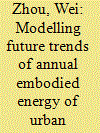

|
|
|
|
|
| Summary/Abstract |
China is the largest driver of growth in the global building sector. The longstanding construction boom across China has generated a massive flow of materials with significant associated embodied energy consumption and carbon emissions. Despite the serious implications for global emissions, there exist a very limited number of macro-level studies on embodied energy of Chinese buildings, with even fewer exploring future scenarios. There is therefore little in the way of an evidence base to offer policy makers. We develop a probabilistic model to forecast the possible trajectories of embodied energy of residential buildings over the medium to long term in the Chinese urban context. Our results provide clear evidence to substantiate the importance of embodied energy of new construction, which we find to be over 0.3 times the operational energy of existing stock between 2010 and 2018. If current trajectories are followed, embodied energy is likely to peak around 2027, with a 95% credible interval ranging from 87 to 283 Mtce (61 to 198 Mtoe) and a mean of 170 Mtce (119 Mtoe). We show that building lifetime has a substantial impact on future annual and cumulative embodied energy. Our findings reinforce the need to take a whole-life perspective to formulate policies addressing building energy as part of China's efforts to meet the announced overarching target of achieving carbon neutrality by 2060.
|
|
|
|
|
|
|
|
|
|
|
|
|
|
|
|
| 9 |
ID:
169714
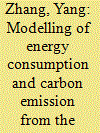

|
|
|
|
|
| Summary/Abstract |
A rapid rise in China's construction scale due to urbanization has resulted in a large amount of energy consumption and carbon emission. In order to achieve carbon emission reduction and energy security, it is important to assess the energy use of and emissions from the building construction sector. This paper presents a China Building Construction Model (CBCM) based on a process-based life cycle assessment (LCA) approach and discusses the trends in energy consumption of and carbon emission regarding China's building construction sector from 2000 to 2016. In 2016, the total energy consumption of the building construction sector was 411 million tce, accounting for approximately 9% of the country's total energy consumption. The construction activities of urban residential, public, and commercial buildings have replaced rural residential buildings as the main source of energy consumption and emission. Construction scale, building structure type, and material production efficiency are the three important driving factors. A decline in China's building construction scale, promotion of new low carbon building structures, and improvement in production efficiency may reduce future energy use and carbon emissions related to the building construction sector.
|
|
|
|
|
|
|
|
|
|
|
|
|
|
|
|
| 10 |
ID:
116720
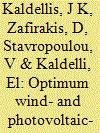

|
|
|
|
|
| Publication |
2012.
|
| Summary/Abstract |
The main aim of the specific research is the comparison of the energy pay-back period of optimum renewable energy sources (RES)-based configurations, meaning wind-battery and photovoltaic-battery stand-alone installations that may ensure the energy autonomy of a typical remote consumer under the condition of minimum life cycle (LC) energy content. In this context, energy autonomy is first ensured on the basis of an appropriate sizing methodology, while accordingly, by developing a calculation algorithm for the estimation of the LC energy content of such energy autonomous systems, minimum LC embodied energy configurations are eventually obtained. On top of that, three representative areas are examined so as to investigate the influence of the local wind and solar potential. According to the results, the sustainable character of both RES-based solutions is designated, especially when comparison with the conventional diesel-engine solution is carried out. On the other hand, the situation is inversed when comparing stand-alone and grid-connected RES systems of the same size, with significant contribution of the battery storage component being reflected.
|
|
|
|
|
|
|
|
|
|
|
|
|
|
|
|
| 11 |
ID:
109622
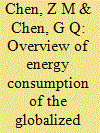

|
|
|
|
|
| Publication |
2011.
|
| Summary/Abstract |
For the globalized world economy with intensive international trade, an overview of energy consumption is presented by an embodied energy analysis to track both direct and indirect energy uses based on a systems input-output simulation. In 2004, the total amounts of energy embodied in household consumption, government consumption, and investment are 7749, 874, and 2009 Mtoe (million tons of oil equivalent), respectively. The United States is shown as the world's biggest embodied energy importer (683 Mtoe) and embodied energy surplus receiver (290 Mtoe), in contrast to China as the biggest exporter (662 Mtoe) and deficit receiver (274 Mtoe). Energy embodied in consumption per capita varies from 0.05 (Uganda) to 19.54 toe (Rest of North America). Based on a forecast for 2005-2035, China is to replace the United States as the world's leading embodied energy consumer in 2027, when its per capita energy consumption will be one quarter of that of the United States.
|
|
|
|
|
|
|
|
|
|
|
|
|
|
|
|
| 12 |
ID:
186471
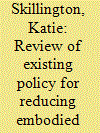

|
|
|
|
|
| Summary/Abstract |
The building sector is a significant contributor to global energy demand and greenhouse gas emissions and thus has a major role in combating climate change. To date, efforts to address this issue have focussed on reducing energy demand during building operation, resulting in significant reductions in this area. However, recent studies have shown that substantial improvements to operational energy efficiency have increased the relative significance of indirect or embodied energy demands and associated greenhouse gas emissions. Subsequently, policies addressing this next frontier of energy and emissions reductions are emerging. To understand different approaches and inform future development, this study reviews existing policy mechanisms targeting embodied energy and greenhouse gas emissions in the building sector for four countries – Australia, Canada, USA and United Kingdom. The study found that voluntary instruments dominate the policy landscape, with regulatory measures largely absent at national levels and confined to inconsistent application across lower levels of governance. Signals of change emerging from the analysis include growing private sector investment and increasing quantitative targets for reduction. The study concludes with the challenges facing this sector of energy governance, alongside recommendations for regulated caps, mandatory LCA reporting, prerequisite requirements in voluntary instruments, data accessibility and resolving methodological inconsistencies.
|
|
|
|
|
|
|
|
|
|
|
|
|
|
|
|
| 13 |
ID:
112261


|
|
|
|
|
| Publication |
2012.
|
| Summary/Abstract |
Role of energy in the manufacturing industry is a major concern for energy and environmental policy design. Issues like energy prices, security of supply and carbon mitigation are often connected to the industry and its competitiveness. This paper examines the role and consequences of embodied energy in the European industry.
To this end, a multi-regional input-output analysis including 59 industrial sectors for all European Union countries and 17 more aggregated industries for other regions of the World is developed. Other segments of the economy are not included. This base is combined with energy consumption, carbon emission as well as bilateral trade data for every sector in all included countries.
Our main result is that embodied energy in manufactured products' imports represents a significant aspect of the energy situation in European industries, with quantities close to the direct energy consumption. These flows can further be broken down for detailed analysis at the sector level thanks to the number of distinct industries included. Results demonstrate that an important part of embodied energy inside European products is not concerned with domestic energy price changes. In addition, a European-wide carbon tax would induce an unbalanced burden on industries and countries.
|
|
|
|
|
|
|
|
|
|
|
|
|
|
|
|
| 14 |
ID:
099364
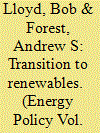

|
|
|
|
|
| Publication |
2010.
|
| Summary/Abstract |
This paper explores energy and physical resource limitations to transitioning from fossil fuels to the large-scale generation of electricity with photovoltaic arrays. The model finds that business as usual models, which involve growth rates in world electricity demand of between 2% and 3.2% p.a., exhibit severe material difficulties before the end of this century. If the growth rate is lowered to 1% p.a., then it may be possible to reach the year 2100 before such difficulties, but it is likely that material constraints will occur early the next century. Steady state scenarios show that silicon based photovoltaic panels could, however, displace fossil fuels before the middle of the century, providing around the same order of magnitude as present (2010) world electricity demand. Scenarios also show that outcomes will be highly dependent upon the rate of improvement of photovoltaic technologies. The analysis does not contend that silicon PV technology is the only technology that will or can be adopted, but as the embodied energy content per kWh generated of this technology is similar to other renewable technologies, such as other solar technologies and wind, it can provide a baseline for examining a transition to a mixture of renewable energy sources.
|
|
|
|
|
|
|
|
|
|
|
|
|
|
|
|
|
|
|
|
|